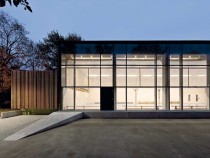
© Jan Bitter
Erected in the 1950s, this primary school in Berlin has been refurbished and once more gives some impression of the generous, landscaped urban planning that originally existed there. The sports hall, which stands somewhat removed from the main ensemble and is reached via a covered walkway, had also suffered from the numerous changes made to its form and function over the years. As well as improving the energy situation, the architects sought to reinterpret the original design quality in an up-to-date manner. The finely dimensioned concrete structure was freed of all extraneous elements, and the floor and roof were newly insulated. A calculation of the energy balance allowed the western face of the hall to be fully glazed, so that there is a high level of daylighting. It was also possible to leave the brick end walls unclad. Their lively surfaces stand in bold contrast to the smooth, pale-blue, resilient flooring and the semi-transparent acoustic soffit screen, which determines the spatial character of the hall. With its light, glass-fibre mesh, the screen imposes a minimal load on the structure and at the same time protects the light fittings and acoustic elements from balls flying around in the hall below. Drawn in a curve down the upper part of the facade, it also protects against insolation. By carefully removing certain elements and achieving a successful interplay of light, colour and materials, the architects have created a hall in which sport is fun again.






